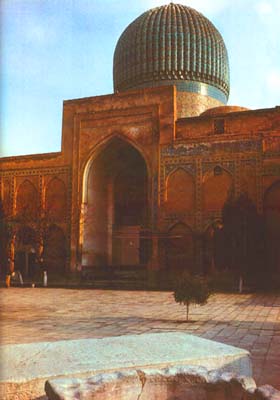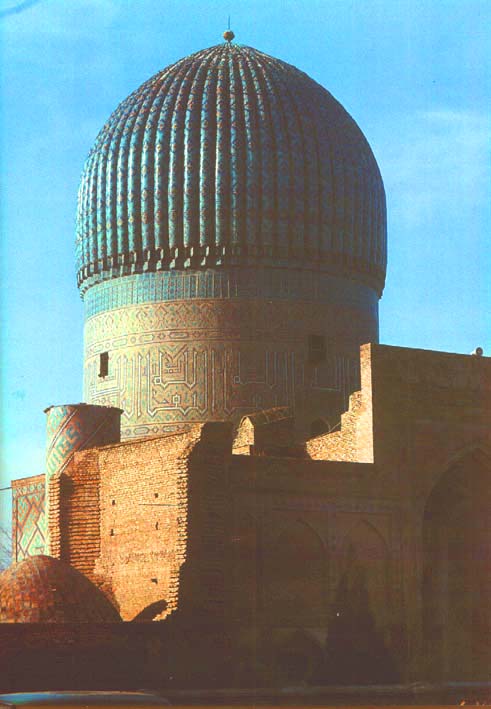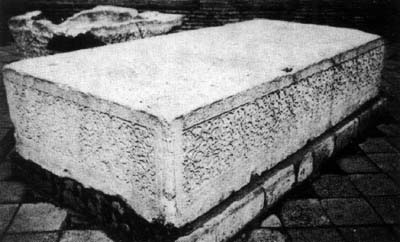Tamerlane died in February 1405 on his way to China with
an invasion force of 200,000 men. His body was perfumed with rose-water,
musk and camphor, placed in a coffin dec-orated with pearls and despatched-in
the dead of night to avoid unsettling his troops-back to Samarkand 400
miles away. He was buried in the mausoleum he had built for his grandson
Mohammed Sultan, who had died fighting in Turkey in 1403. It became known
as Gur Emir-the Ruler's Tomb-and nowadays it stands among quiet, un-Sovietized
backstreets not far along Ulitsa Akhunbabaeva from the Hotel Samarkand.
 The
first version of Gur Emir, completed in 1404, was not grand enough for
Tamerlane. He had its famous ribbed cantaloupe dome, and the drum on which
it stood, rebuilt on the scale of the Bibi Khanym mosque in two weeks flat.
The outer dome is now 32 m high and the inner 18 In, with a complex system
of supporting struts between them. Round the drum beneath the outer dome
runs a kufic inscription 10 m high: 'There is no God but Allah and Mohammed
is his prophet.' Under this, in an octagonal hall, lie six cenotaphs of
white marble and one of jade. The marble ones commemorate, among others,
Mohammed Sultan the grandson; Shah Rukh, Timor's youngest son and heir,
who ruled the rapidly shrinking Timurid empire from Herat in modern Afghanistan;
Ulug Bek, who ruled Samarkand as Shah Kukh's viceroy; and Mir Said Ecrekh,
sage, descendent of the Prophet and Tamerlane's spiritual mentor. The
first version of Gur Emir, completed in 1404, was not grand enough for
Tamerlane. He had its famous ribbed cantaloupe dome, and the drum on which
it stood, rebuilt on the scale of the Bibi Khanym mosque in two weeks flat.
The outer dome is now 32 m high and the inner 18 In, with a complex system
of supporting struts between them. Round the drum beneath the outer dome
runs a kufic inscription 10 m high: 'There is no God but Allah and Mohammed
is his prophet.' Under this, in an octagonal hall, lie six cenotaphs of
white marble and one of jade. The marble ones commemorate, among others,
Mohammed Sultan the grandson; Shah Rukh, Timor's youngest son and heir,
who ruled the rapidly shrinking Timurid empire from Herat in modern Afghanistan;
Ulug Bek, who ruled Samarkand as Shah Kukh's viceroy; and Mir Said Ecrekh,
sage, descendent of the Prophet and Tamerlane's spiritual mentor.
The seventh cenotaph is Tamerlane's. As he lay dying he
had whispered, 'Only a stone, and my name upon it,' but he got what was
then the biggest slab of jade in the world. Some say it was sent from the
mountains of Chinese Turkestan by a Mongolian princess; others that Mug
Bek brought it from there himself in 1411. The Persian Invader Nadir Shah
tried to carry it away in 1740 but It broke in two so he left it alone.
Cemented back together, it normally appears black in the low light that
filters through the four fretted arches round the hall. Only direct sunlight
through the east door in the early morning brings out its true green.
 No expense was spared on the hall itself. Its walls are covered
with hexagonal green alabaster tiles up to a band of once-gilded marble
at head height. Higher up, bands of calligraphy frame clusters of stalactites
and blue and gold geometric panels.. Laid end on end, the gilding on the
underside of the dome would stretch for 3 km.. Below the ceno-taphs, 3rn'down
in a crypt closed to the public, lie the real graves and tombstones.
No expense was spared on the hall itself. Its walls are covered
with hexagonal green alabaster tiles up to a band of once-gilded marble
at head height. Higher up, bands of calligraphy frame clusters of stalactites
and blue and gold geometric panels.. Laid end on end, the gilding on the
underside of the dome would stretch for 3 km.. Below the ceno-taphs, 3rn'down
in a crypt closed to the public, lie the real graves and tombstones.
There are two more Timurid tombs nearby: The grandiose
but uninspiring Mausoleum Rukhabad, built for Sheikh Burhanuddin Sagharji
in the 1380s on what is now Registanskaya Ulitsa near the Tabbasum Restaurant;
and the modest-sized Mausoleum Ak-Saray built in the 1470s for the last
of the Timurids a short distance south-east of Cur Emir on Ulitsas Akhunbabaeva
and Umarova.
 In
the countyard stands the famous Ak -Tash throne stone (brought in from
the citadel) which was used for coronation ceremonies of the Sheibanid
dynasty. In
the countyard stands the famous Ak -Tash throne stone (brought in from
the citadel) which was used for coronation ceremonies of the Sheibanid
dynasty.
[back]
|
